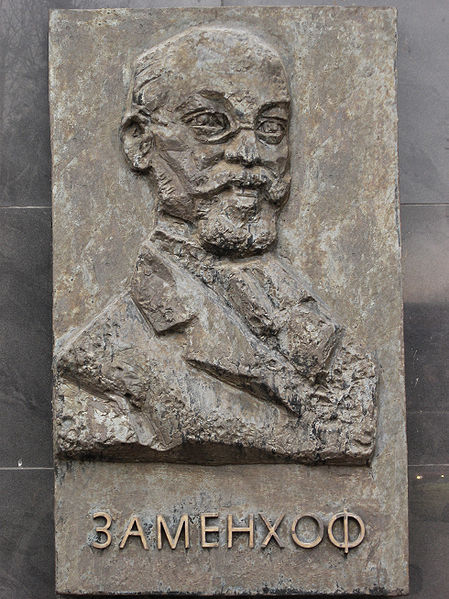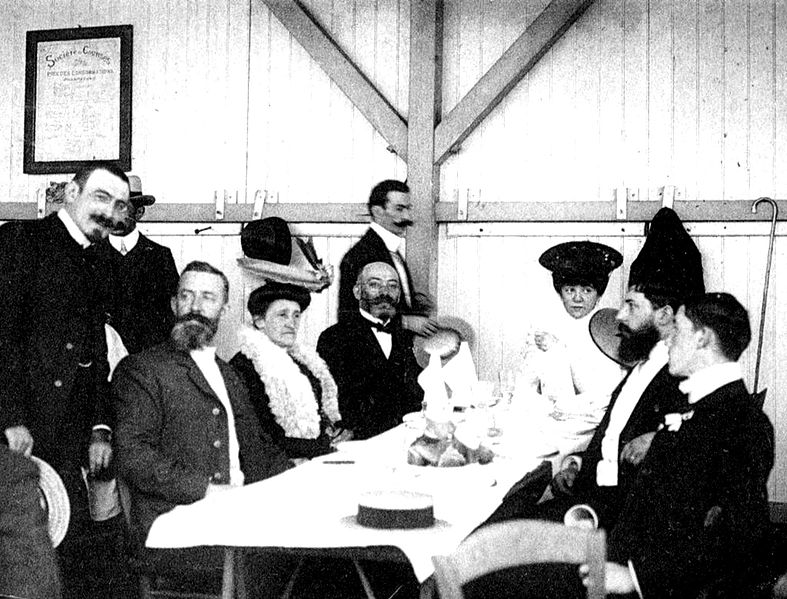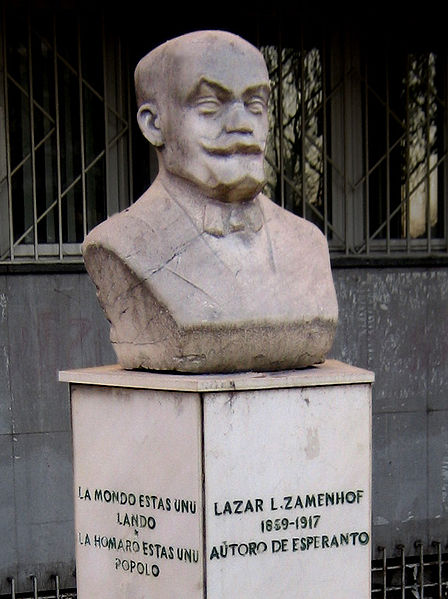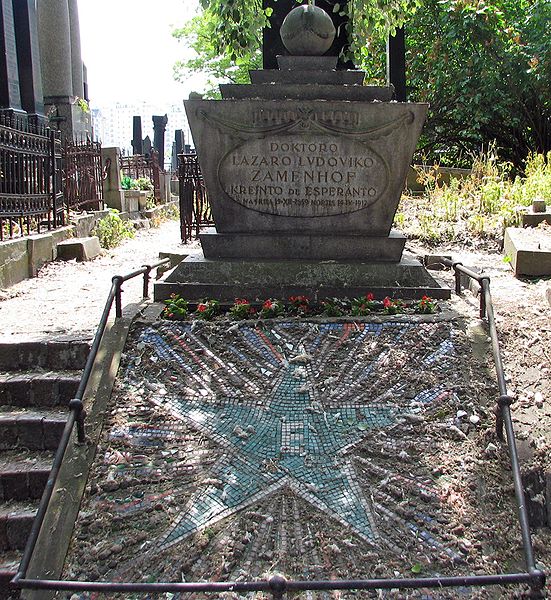<Back to Index>
- Economist Henry Charles Carey, 1793
- Engineer and Architect Alexandre Gustave Eiffel, 1832
- Inventor of Esperanto Ludwig Lazarus Zamenhof, 1859
PAGE SPONSOR
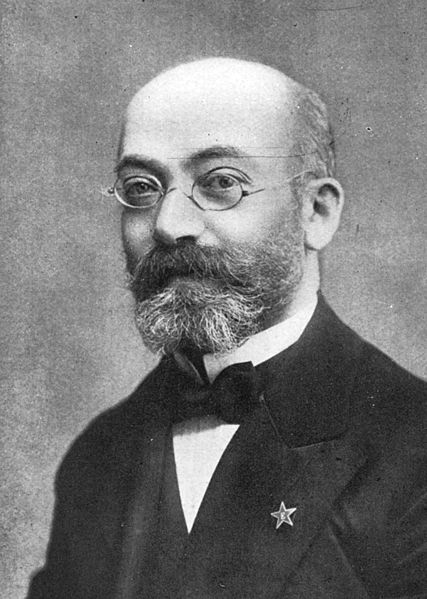
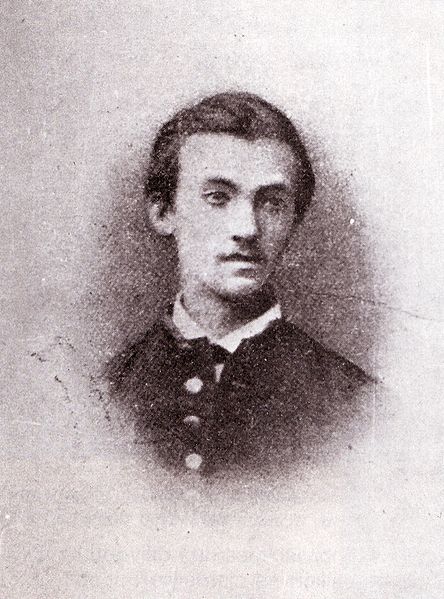
Ludwig Lazarus Zamenhof (born Leyzer Leyvi Zamengov; December 15, 1859 – April 14, 1917) was the inventor of Esperanto, the most successful constructed language designed for international communication.
Zamenhof was born on December 15 (December 3 OS), 1859 in the town of Białystok in the Russian Empire (now part of Poland). He considered his native language to be his father's Russian (or perhaps Belarusian, which was not considered distinct from Russian at the time and which appears to have had a strong influence on Esperanto phonology), but he also spoke his mother's Yiddish natively; as he grew older, he spoke more Polish, and that became the native language of his children. His father was a teacher of German, and he also spoke that language fluently, though not as comfortably as Yiddish. Later he learned French, Latin, Greek, Hebrew, and English, and had an interest in Italian, Spanish and Lithuanian.
In addition to the Yiddish speaking Jewish majority, the population of Białystok was made up of three other ethnic groups: Poles, Germans, and Belarusians.
Zamenhof was saddened and frustrated by the many quarrels among these
groups. He supposed that the main reason for the hate and prejudice lay
in mutual misunderstanding, caused by the lack of one common language that would play the role of a neutral communication tool between people of different ethnic and linguistic backgrounds.
As a student at secondary school in Warsaw, Zamenhof made attempts to create some kind of international language with a grammar that was very rich, but also very complex. When he later studied English, he decided that the international language must have a simpler grammar. Apart from his parents' native languages Russian and Yiddish and his adopted language Polish, his linguistics attempts were also aided by his mastering of German, a good passive understanding of Latin, Hebrew and French, and a basic knowledge of Greek, English and Italian.
By 1878, his project Lingwe uniwersala was almost finished. However, Zamenhof was too young then to publish his work. Soon after graduation from school he began to study medicine, first in Moscow, and later in Warsaw. In 1885, Zamenhof graduated from a university and began his practice as a doctor in Veisiejai and after 1886 as an ophthalmologist in Płock and Vienna. While healing people there, he continued to work on his project of an international language.
For
two years he tried to raise funds to publish a booklet describing the
language until he received the financial help from his future wife's father. In 1887, the book titled Lingvo internacia: Antaŭparolo kaj plena lernolibro (International language: Foreword and complete textbook) was published in Russian under the pseudonym "Doktoro
Esperanto" (Doctor Hopeful), from which the name of the language
derives. For Zamenhof this language, far from being merely a
communication tool, was a way of promoting the peaceful coexistence of
different people and cultures.
In 1879, Zamenhof wrote the first grammar of the Yiddish language, which he published in part years later in the Yiddish magazine Lebn un visnshaft. The complete original Russian text of this manuscript with parallel Esperanto translation was only published in 1982 (translated by Adolf Holzhaus in L. Zamenhof, provo de gramatiko de novjuda lingvo, Helsinki, p. 9 - 36). In this work, not only does he provide a review of Yiddish grammar, but also proposes its transition to the Latin script and other orthographic innovations. In the same period, Zamenhof wrote some other works in Yiddish, including perhaps the first survey of Yiddish poetics.
In 1882, a wave of pogroms in the Russian empire motivated Zamenhof to take part in the early Zionist movement, the Hibbat Zion. He left the movement in 1887, and in 1901 published a statement in Russian with the title Hillelism, in which he argued that the Zionist project could not solve the problems of the Jewish people.
In 1914, he politely declined an invitation to join a new organization of Jewish Esperantists, the TEHA. In his letter to the organizers, he said: "I am profoundly convinced that every nationalism offers humanity only the greatest unhappiness... It is true that the nationalism of oppressed peoples -- as a natural self defensive reaction -- is much more excusable than the nationalism of peoples who oppress; but, if the nationalism of the strong is ignoble, the nationalism of the weak is imprudent; both give birth to and support each other..."
Among the many works Zamenhof translated into Esperanto is the Hebrew Bible or Old Testament.
Zamenhof died in Warsaw on April 14, 1917, and is buried in the Okopowa Street Jewish Cemetery in that city.
Besides his linguistic work, Zamenhof published a religious philosophy he called Homaranismo (loosely translated as humanitarianism), based on the principles and teachings of Hillel the Elder.
Zamenhof and his wife Klara raised three children, a son, Adam, and two daughters, Sofia and Lidia. All three were murdered in the Holocaust. Lidia Zamenhof in
particular took a keen interest in Esperanto, and as an adult became a
teacher of the language, traveling through Europe and to America to
teach classes in it. Through her friendship with Martha Root, Lidia accepted Bahá’u’lláh and became a member of the Bahá’í faith.
As one of its social principles, the Bahá’í faith teaches
that an auxiliary world language should be selected by the
representatives of all the world's nations.
Zamenhof's parents gave him the Hebrew name Eliezer, which appeared on his birth certificate in its Yiddish form Leyzer. In his adolescence he used both Leyzer and the Russian equivalent Lazar (the form Lazarus is often used in English texts). In some Russian documents Lazar was followed by the patronymic Markovich.
While
at university, Zamenhof began using the Russian name Lyudovik (often
transcribed Ludovic; in English the form Ludwig is also used) in place
of Lazar. When his brother Leon became a doctor and started signing his
name "Dr L. Zamenhof", Ludwik
reclaimed his birth name Lazar and from 1901 signed his name "Dr L.L.
Zamenhof". The two L's do not seem to have specifically represented
either name, and the order Ludwik Lazar is a modern convention. Zamenhof may have chosen the name Ludwik in honor of Francis Lodwick (or Lodowyck), who in 1652 had published an early conlang proposal. His
family name was originally written Samenhof, in German orthography; the
spelling Zamenhof reflects the romanization of the Yiddish spelling זאַמענהאָף, as well as the Esperanto and Polish spellings.
In 1910, Zamenhof was nominated for the Nobel Peace Prize, by four British Members of Parliament (including James O'Grady, Philip Snowden) and Professor Stanley Lane Poole. (The Prize was instead awarded to the International Peace Bureau.)
The minor planet (1462) Zamenhof is named in his honor. It was discovered on February 6, 1938, by Yrjö Väisälä. Also, hundreds of city streets, parks, and bridges worldwide have been named after Zamenhof. In Lithuania, the best known Zamenhof Street is in Kaunas, where he lived and owned a house for some time. There are others in France, Hungary, Poland, the Czech Republic, Spain (mostly in Catalonia), Italy, Israel, and Brazil. There are Zamenhof Hills in Hungary and Brazil, and a Zamenhof Island in the Danube River.
In some Israeli cities, street signs identify Esperanto's creator and give his birth and death dates, but refer to him solely by his Jewish name Eliezer (a variant of which, El'azar, is the origin of Lazarus). Zamenhof is honored as a deity by the Japanese religion
Oomoto, which encourages the use of Esperanto among its followers. Also, a genus of lichen has been named Zamenhofia rosei in his honour.His birthday, December 15, is celebrated annually as Zamenhof Day by users of Esperanto. On December 15, 2009, Esperanto's green starred flag flew on the Google search web page, in a commemorative Google Doodle to mark Zamenhof's 150th birthday.
The house of the Zamenhof family, dedicated to Ludwik Zamenhof and the Białystok Esperanto Centre, are sites of the Jewish Heritage Trail in Białystok, which was opened in June 2008 by volunteers at The University of Białystok Foundation.
